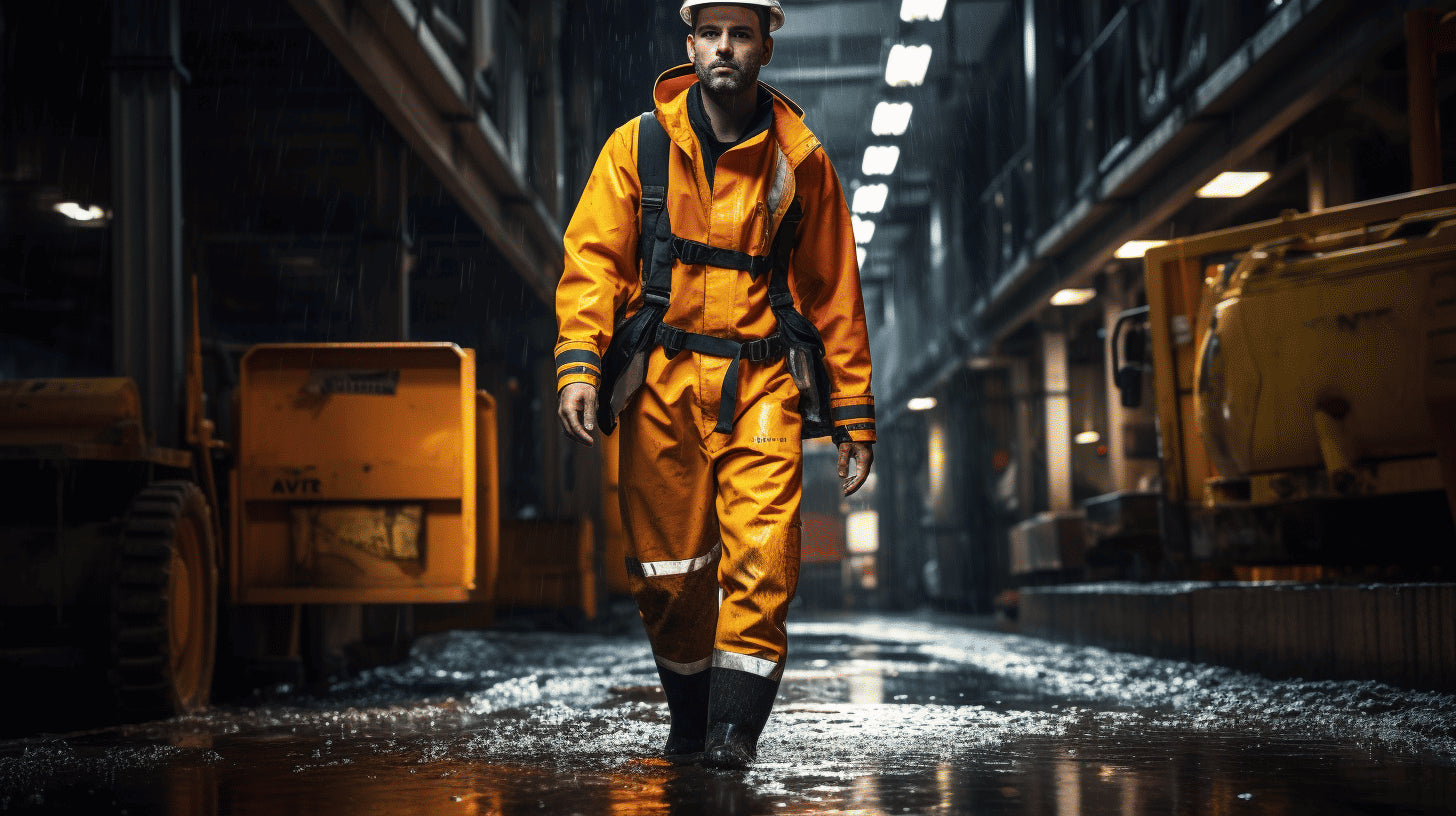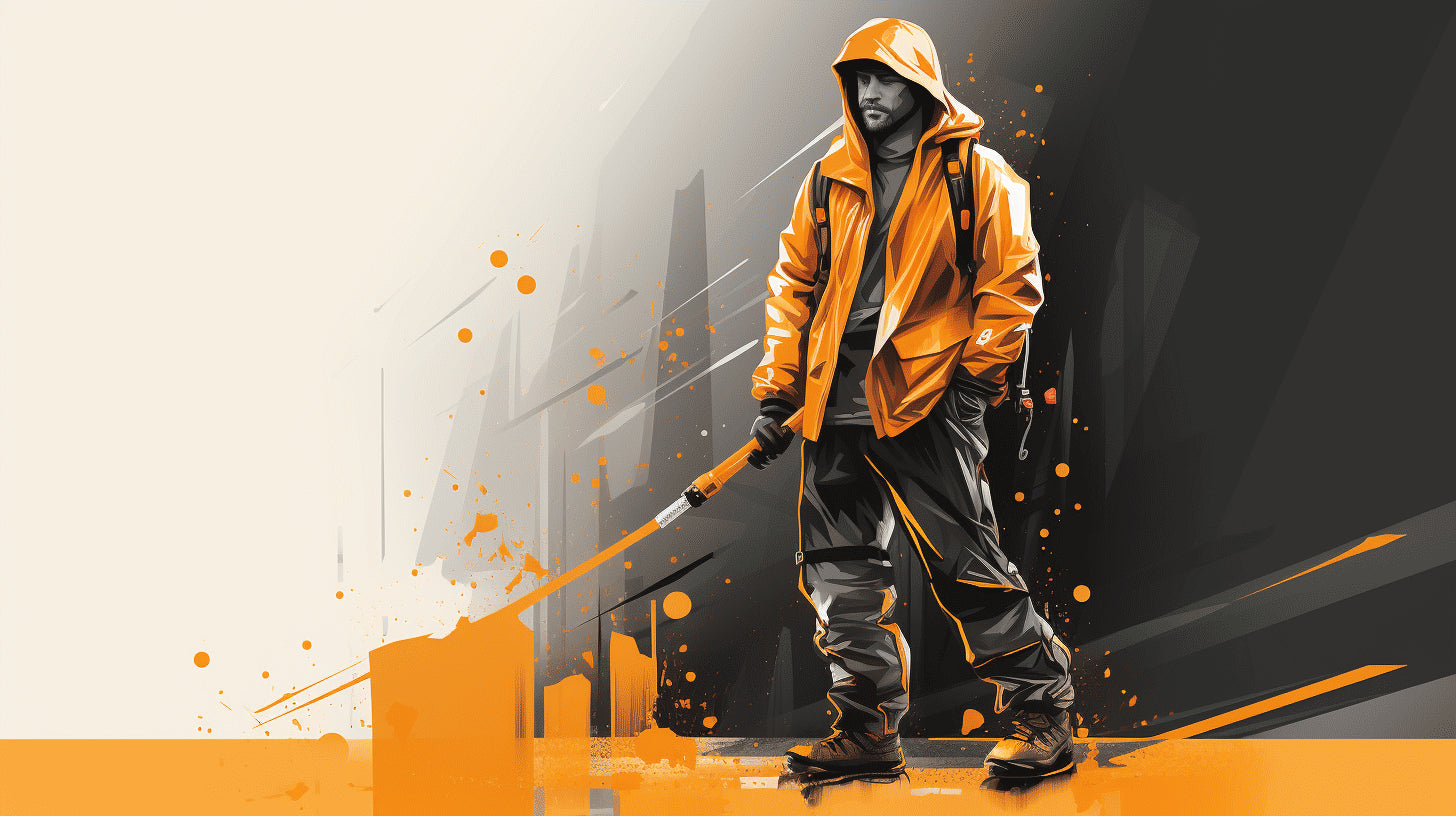Why Tear-Resistant Rain Gear is Essential for Construction Workers
In the construction industry, the significance of having the right safety equipment cannot be overstated. Among these essentials is tear-resistant rain gear. While it might initially seem like a mundane addition to a construction worker's protective kit, the utility and advantages it brings to the table are immense. In the subsequent paragraphs, we'll delve deeper into why tear-resistant rain gear is not just beneficial, but essential for construction personnel.
Safety Concerns
Torrential rains and stormy winds can turn any site into a challenging workplace. This is especially true for construction sites littered with sharp tools, metallic structures, and harmful debris. Tear-resistant rain gear offers the first line of defence against these work environment hazards.
- Protection from sharp objects: Sturdy, tear-resistant fabric forms a robust barrier against accidental scratches, scrapes, and jabs that can lead to serious injuries.
- Impenetrable shield: The gear also acts as an impenetrable shield, diminishing the chances of severe harm caused by flying debris during a storm or heavy winds.
- Visibility gear: Another subtle, yet critical, feature embedded in tear-resistant rain gear is high-visibility accents. These reflective bands dramatically increase visibility in low light conditions, decreasing the risk of accidents.
"Construction sites are often dynamic and fast-paced, and having the right gear is not just about comfort; it's a matter of safety."
Work Efficiency
Tear-resistant rain gear is not only about safety. This specialized clothing also has a profound impact on work efficiency. Keeping construction personnel comfortable and dry in adverse weather conditions can drive a surprising boost in productivity.
- Decrease in downtime: The waterproof nature of this gear allows workers to continue their duties, even in an unexpected downpour, significantly reducing weather-related downtime.
- Enhanced comfort: When employees are comfortable, warm, and dry, they're more likely to perform their duties effectively and with greater enthusiasm, further increasing productivity.
Health Protection
Last
Features to Look for in Tear-Resistant Rain Gear
When it comes to protection from the rain, you need gear that is not only resistant to water but also resilient enough to withstand the vagaries of the elements. With advancements in textile technologies, tear-resistant rain gear is becoming increasingly accessible. They offer more extended durability while ensuring necessary rain protection. However, there's much more to consider beyond just the 'tear-resistant' label. To find the perfect rain gear, be it a jacket, a tent, or a pair of waterproof pants, pay attention to factors like the material, design, and of course, durability.
Material
Let’s dive right in and talk about material first. The fabric of your rain gear is crucial to its performance and longevity. Look for materials that are both water-resistant and tear-resistant.
- Nylon: Commonly used in rain jackets and umbrellas, nylon is well-known for its tear-resistance as well as its waterproofing properties.
- Polyester: This synthetic material, sometimes paired with nylon for added strength, is inherently waterproof and resists tearing.
- Polyvinyl Chloride (PVC): Although a bit heavier than nylon or polyester, PVC offers exceptional water and tear resistance.
Remember, a well-chosen material will keep you dry in the rain and is less likely to be damaged if accidentally snagged or punctured!
Design
The design is as important as the material, as it contributes to the usability of the rain gear. The key design features to look for include:
- Seams: Ensure they are sealed or taped to prevent any leaks.
- Zippers: They should be water-resistant.
- Construction: The construction should promote freedom of movement without putting undue stress on the fabric, which can lead to tearing. Additionally, the design should facilitate easy packing and transportation.
A well-designed rain gear invites the right balance of functionality and comfort, turning the gloomiest of rainy days into an enjoyable experience.
Durability
Finally, the real test of tear-resistant rain gear lies in its durability. Yes, it’s about standing strong against potential tears, but also about surviving the rigors of heavy use and washing. When assessing durability, pay attention to:
- Material Quality: High-quality materials usually denote long-lasting gear.
- Maintenance Needs: Gear that is easy to clean and care for will often last longer.
- User Reviews: Check customer reviews and ratings for insights into the product’s long-term performance.
Budget-friendly options
Budgeting is an essential part of life that many people overlook. Although it might seem overwhelming at first, understanding how to manage your finances can significantly improve your lifestyle. Whether you're just starting out or have been buckling down on your budget for a while now, exploring budget-friendly options can be a game-changer. This section will delve into the nuances of evaluating the cost, dissecting the concept of investment versus value, and offering practical tips for those keen on shopping economically.
Evaluating the Cost
Before making a purchase, it's crucial to evaluate the cost thoroughly. Assess how much value the product or service will bring to your life and how frequently you plan to use it. For example, paying more for a high-quality item that you'll use daily might make more sense rather than opting for a cheaper alternative that easily wears out. Hence, a good rule of thumb when evaluating cost is to focus on the bigger picture instead of just the price tag.
Investment vs. Value
The concept of 'investment versus value' goes hand in hand when making financial decisions. Sometimes the best value for money may not be the cheapest item available but the one that will last longer and perform better. So instead of seeking out the cheapest options, consider investing in quality. That high-end kitchen appliance may be pricey, but if it lasts for ten years instead of just two, you'd save money in the long run.
Shopping Tips
Here's how to be a savvy shopper:
- Plan your purchases ahead: Plan what you need and stick to the list to avoid impulsive purchases.
- Compare prices: A simple price comparison can help you find the best deal.
- Opt for quality: Again, cheap doesn't always mean value.
- Shop during sales: Purchasing items during sales can help you save a considerable amount.
Hopefully, these insights give you a new perspective on budget-friendly options. Remember, it's not always about finding the least expensive choice but rather making smart decisions that provide the best value.
Proper Care and Maintenance for Longevity
When it comes to preserving your much-loved possessions, be it your grandmother's antique brooch or your brand-new smartphone, the best place to start is with proper care and maintenance. This passage will serve as a comprehensive guide to the world of maintaining items for long-lasting use. We will take you on a nuanced journey exploring three unique aspects of property upkeep: cleaning and storage, periodic checks, and insightful repair tips.
Cleaning and Storage
One of the simplest yet most effective ways to guarantee the preservation of an item is to keep it clean and well-stored. No doubt, the specifics may vary based on the particular item, but a few general practices can apply to a wide array of possessions.
- Cleanliness is essential: Regular cleaning can prevent the buildup of dirt and dust, which may lead to the deterioration of your item. Use proper cleaning agents, and always ensure they're specific to the item you're cleaning – as the wrong cleaner could end up doing more harm than good.
- Store properly: The prime enemy of longevity is often environmental factors like humidity and temperature changes. To preserve your items, they should be stored in suitable conditions.
Periodic Checks
Even the best-kept items may break down every once in a while. That's why it's important to carry out periodic checks. Not only do these checks help you catch potential problems before they spiral out of control, but they also ensure your items are operating at their very best.
- Spot signs of wear and tear: Regular wear and tear is expected in everyday items. The main trick is to identify them early and take necessary action.
- Understand the item's life cycle: Each item has a specific lifecycle with signs indicating when it's nearing its end. Knowing and understanding these signs can go a long way in maintaining the item for a longer time.
Repair Tips
Finally, repairing. Now, this can be a slightly intimidating topic, especially for those who aren't naturally handy. But here's the good news: while some complex tasks should be left to the professionals, most common repair tasks are fairly manageable with the right resources, knowledge, and a little patience.
- DIY with caution: It's great to be self-reliant but know your limits. If something seems overly complicated, it's better to consult a professional.
- Use the right tools: Always use a tool suitable for the specific repair task at hand. The wrong tool can cause more damage or make the task more difficult.
With these tips on cleaning, routine checks, and repairs, you increase the likelihood of elongating the lifespan of your prized possessions. Think of these practices as investments for long-term use, ensuring that your items remain in top-notch condition for as long as possible. Stick to these guidelines and watch as your items defy time, lasting well beyond their standard lifespans.
How to Correctly Size Rain Gear for Optimal Protection
In the midst of a sudden downpour, nothing comes to the rescue like the perfect rainwear. But it's not just about finding something that shields you from the rain; having the right size is paramount for optimal protection. Understanding how to correctly size your rain gear not only ensures you stay dry but can also significantly enhance your mobility and comfort level during inclement weather.
Why Correct Sizing Matters
There are several reasons why you should not overlook the importance of properly sizing your rain gear:
- Comfort: Oversized rain gear can be bulky and restrictive, while gear that's too small may be uncomfortable and limit your range of motion.
- Full Coverage: Accurate sizing guarantees full protection from the elements, preventing rain or snow from sneaking in through gaps.
- Durability: Well-fitted rain gear experiences less strain and wear, increasing the lifespan of the product.
Remember, choosing the right size isn't just about weather-proofing yourself - it's also about ensuring you can move freely and comfortably in any situation.
How to Measure
Getting the correct measurements for your rain gear doesn't have to be a daunting task. Here's a quick guide to help you out:
- Chest: Measure around your chest at its fullest point.
- Waist: Measure around your waist at the navel level.
- Hip: Measure around the widest part of your lower body.
- Sleeve Length: Measure from the shoulder's highest point down to your wrist.
Most manufacturers provide sizing charts that you can match with your measurements to find the perfect fit. Keep in mind, these are general guidelines. Always check product-specific sizing instructions, as different brands might have their own measurements.
Common Sizing Issues
Despite our best efforts, sometimes we still run into sizing issues. Some common problems include:
- Sleeves too long or short: The sleeves should not restrict your arm movements and should cover your wrist when your arm is stretched out.
- Gear too tight or loose: Rain gear should be roomy enough for you to wear a sweater or jacket underneath, but not so baggy that it gets in your way or allows rain to seep in.
- Inadequate coverage: Ensure the jacket length covers your torso completely, and the pants are long enough to keep the rain from splashing onto your shoes.
With these tips, you can confidently choose rain gear that is not only functional but also fits like a glove. Remember, a well-sized rain outfit is the first line of defense against the elements, ensuring you stay dry while maintaining your comfort and mobility.
Conclusion
To brave the unpredictable weather conditions, you need tear-resistant rain gear that serves as a reliable shield. As construction workers who are constantly in the outdoor loop, investing in high-quality, durable and comfortable rain gear is not a luxury—it's a necessity. By considering the material, design, durability, and correctly sizing the rain gear, you enhance your work efficiency, ensure your safety, and protect your health.
Choosing budget-friendly options may be a challenge but assessing the investment against the value offered by the product can help guide your purchasing decisions. And once you get hold of the ideal rain gear, proper care, and maintenance become your responsibility to ensure its longevity.
Hurricane Raingear offers products designed with these essential features in mind, providing an optimal balance of safety, comfort, and cost-effectiveness to meet your needs. Our commitment to customer satisfaction also means you get product support whenever needed. Ultimately, working in the rain should never compromise your productivity or health, and the right rain gear ensures it doesn't have to.
Frequently Asked Questions
-
What are some budget-friendly rain gear options for construction workers?
Some budget-friendly rain gear options for construction workers include PVC raincoats, waterproof ponchos, and lightweight rain suits.
-
Is tear-resistance an important feature for rain gear used by construction workers?
Yes, tear-resistance is crucial for rain gear used by construction workers as they are often exposed to rough and abrasive surfaces. Look for rain gear made from durable materials like ripstop nylon or PVC-coated polyester.
-
What features should I consider when choosing rain gear for construction work?
When choosing rain gear for construction work, consider features such as waterproof or water-resistant material, sealed seams for added protection, adjustable hood and cuffs, reinforced knee and elbow patches, and reflective elements for better visibility.
-
Can I find affordable tear-resistant rain gear that is also breathable?
Yes, there are affordable tear-resistant rain gear options available that are also breathable. Look for rain gear that has vents or mesh linings to allow airflow and prevent overheating during physical work.
-
How often should I replace my rain gear for construction work?
The lifespan of rain gear depends on the quality of materials used, frequency of use, and level of wear and tear. It is recommended to inspect your rain gear regularly and replace it if you notice significant damage, loss of waterproofing, or compromised tear-resistance.























Leave a comment
This site is protected by hCaptcha and the hCaptcha Privacy Policy and Terms of Service apply.